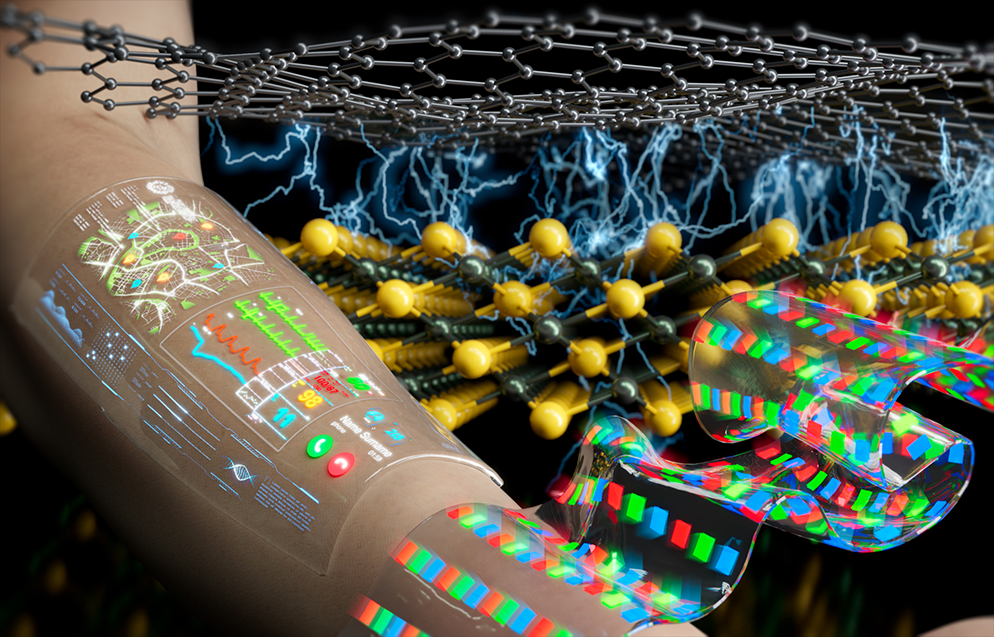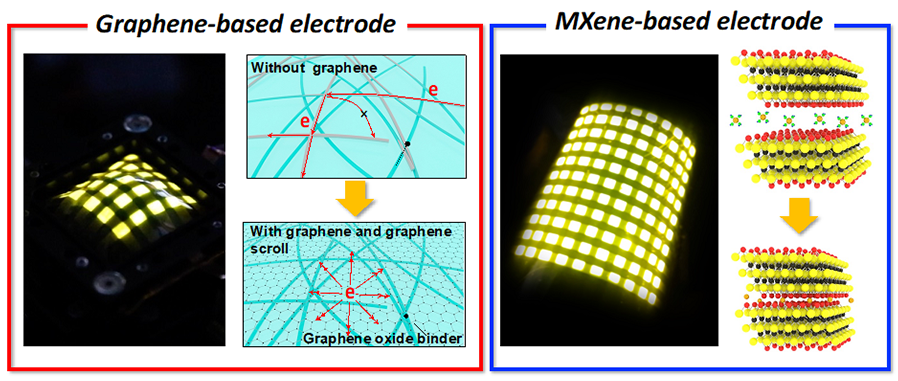
Fine-tuning the charge injection properties stretchable electrodes using two-dimensional materials
Demonstration of three inch large-area passive matrix ISOLEDs
Establishment of electrode lamination method for ISOLEDs
Professor Tae-Woo Lee in the Department of Materials Science and Engineering has developed highly efficient organic light-emitting diodes for wearable devices using two-dimensional graphene and MXene in the electrode. Previously, wearable devices were bulky and tethered by cables. However, advancements in soft materials and processing technology have enabled the development of portable wearable devices. Stretchable displays are a fundamental component of wearable devices as they can visualize sensor signals. However, existing stretchable luminescent devices suffer from low efficiency due to the low charge injection property of the electrode material, such as silver nanowires (AgNW). Therefore, a significant breakthrough in developing new materials with high conductivity and easy electron injection is necessary to overcome this challenge.
Prof. Lee's team has developed a two-dimensional stretchable electrode that overcomes the intrinsic limitations of silver nanowires by applying a graphene layer. The graphene layer tunes the work function and promotes charge spreading, allowing for efficient charge injection at the interface. Moreover, the team used the electrode as both the anode and cathode, which is a significant advancement in stretchable electrode materials. Previous research mainly focused on the stretchable anode material, but the cathode posed a challenge due to the lack of highly reactive alkali metals with high stretchability. However, the team coated a newly developed conjugated polymer electrolyte on the stretchable electrode, creating a low work function electrode of 3.57 eV even in the air. This resulted in a high-efficiency stretchable luminescent device of 20.3 cd/A, the highest achieved to date. Furthermore, the team demonstrated its technology by applying it to large-scale devices, including a 3-inch 5x5 passive matrix ISOLED.
To enhance the solution processibility for ISOLED, Prof. Lee's team replaced graphene with MXene, a two-dimensional material discovered in 2011. These materials are made up of a few atoms-thick layers of transition metal carbides or nitrides and have demonstrated impressive properties such as metal-like electrical conductivity and tunable surface and electronic properties. Despite these benefits, practical applications of MXenes have been limited due to poor environmental stability and a high charge injection barrier at the electrode and organic interfaces. However, the team addressed this problem by developing an environmentally stable MXene conductive electrode with high conductivity and a 5.84 eV work function. Through this, they managed to maintain the electrical properties of MXene, while eliminating the issue of MXene thin films’ poor environmental stability.
Prof. Lee said, "Our team has achieved both anode and cathode implementation through the surface and interfacial modification of electrodes using graphene and MXene. Also, we have developed the highly efficient ISOLED with excellent light-emitting efficiency." He added, "This research serves as a comprehensive guide for the development and application of stretchable displays for wearable electronic devices."

Figure
Intrinsically-stretchable/wearable passive matrix OLEDs using graphene and
MXene as electrodes
References
1. Zhou, H., Han, S. J., Harit, A. K., Kim, D. H., Kim, D. Y., Choi, Y. S., Kwon, H., Kim, K. N., Go, G. T., Yun, H. J., Hong, B. H., Suh, M. C., Ryu, S. Y., Woo, H. Y., and Lee, T. W. Adv. Mater. 2022, 34, 2203040.
2. Han, S. J., Zhou, H., Kwon, H., Woo, S.-J., and Lee, T.-W. Adv. Funct. Mater. 2023, 33, 2211150.
3. Ahn, S., Han, T.-H., Maleski, K., Song, J., Kim, Y.-H., Park, M.-H., Zhou, H., Yoo, S., Gogotsi, Y., and Lee, T.-W. Adv. Mater. 2020, 32, 2000919.
4. Zhou, H., Han, S. J., Lee, H.-D., Zhang, D., Anayee, M., Jo, S. H., Gogotsi, Y., and Lee, T.-W. Adv. Mater. 2022, 34, 2270288.
1. Zhou, H., Han, S. J., Harit, A. K., Kim, D. H., Kim, D. Y., Choi, Y. S., Kwon, H., Kim, K. N., Go, G. T., Yun, H. J., Hong, B. H., Suh, M. C., Ryu, S. Y., Woo, H. Y., and Lee, T. W. Adv. Mater. 2022, 34, 2203040.
2. Han, S. J., Zhou, H., Kwon, H., Woo, S.-J., and Lee, T.-W. Adv. Funct. Mater. 2023, 33, 2211150.
3. Ahn, S., Han, T.-H., Maleski, K., Song, J., Kim, Y.-H., Park, M.-H., Zhou, H., Yoo, S., Gogotsi, Y., and Lee, T.-W. Adv. Mater. 2020, 32, 2000919.
4. Zhou, H., Han, S. J., Lee, H.-D., Zhang, D., Anayee, M., Jo, S. H., Gogotsi, Y., and Lee, T.-W. Adv. Mater. 2022, 34, 2270288.


